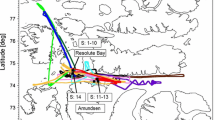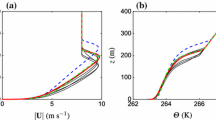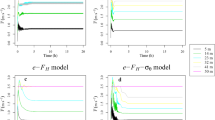Abstract
The dissipation, ε, of turbulent kinetic energy (TKE) is a key parameter in atmospheric boundary-layer (ABL) models. Besides being a sink for momentum, it is often used together with the TKE to define an internal turbulence time scale for closure relations. A prognostic formulation for the dissipation of TKE is formulated, based on isotropic tensor modeling methods. The formulation is coupled to a level 2.5 second-order closure model and evaluated against measurements taken in horizontally homogeneous conditions, as well as against a tailored length-scale formulation. A formulation suitable for convective as well as neutral and stable ABLs is suggested.
Similar content being viewed by others
References
Andrén, A.: 1990, ‘Evaluation of a Turbulence Closure Scheme Suitable for Air-Pollution Applications’, J. Appl. Meteorol. 29, 224–239.
Brost, R. A., Wyngaard, J. C. and Lenschow, H.: 1982, ‘Marine Strataocumulus Layers. Part II: Turbulence Budgets’, J. Atmos. Sci. 39, 818–836.
Caughey, S. J. and Palmer, S. G.: 1979, ‘Some Aspects of Turbulence Structure Through the Depth of the Convective Boundary Layer’, Quart. J. Roy. Meteorol. Soc. 105, 811–827.
Caughey, S. J., Wyngaard, J. C. and Kaimal, J. C.: 1970, ‘Turbulence in the Evolving Stable Boundary Layer’, J. Atmos. Sci. 36, 1041–1052.
Daly, B. J. and Harlow, F. H.: 1970, ‘Transport Equations of Turbulence’, Phys. Fluids 13, 2634–2649.
Duynkerke, P. G.: 1988, ‘Application of the E-ε Turbulence Closure Model to the Neutral and Stable Atmospheric Boundary Layer’, J. Atmos. Sci. 45, 865–880.
Enger, L.: 1986, ‘A Higher Order Closure Model Applied to Dispersion in a Convective ABL’, Atmos. Environ. 20, 879–894.
Grant, A. L. M.: 1986, ‘Observations of Boundary Layer Structure Made During the KONTUR Experiment’, Quart. J. Roy. Meteorol. Soc. 112, 825–841.
Hanjalic, K. and Launder, B. E.: 1972, ‘A Reynolds Stress Model of Turbulence and its Application to Thin Shear Flows’, J. Fluid Mech. 52, 609–638.
Helfand, H. M. and Labraga, J. C.: 1988, ‘Design of a Nonsingular Level 2.5 Second-Order Closure Model for the Prediction of Atmospheric Turbulence’, J. Atmos. Sci. 45, 113–132.
Launder, B. E., Reece, G. J. and Rodi, W.: 1975, ‘Progress in the Development of a Reynolds-Stress Turbulence Closure’, J. Fluid. Mech. 68, 537–566.
Lumley, J. L.: 1979, ‘Computational Modeling of Turbulent Flows’, Adv. Appl. Mech. 18, 123–176.
Lumley, J. L. and Newman, G. R.: 1977, ‘The Return to Isotropy of Homogeneous Turbulence’;. J. Fluid Mech. 82, 161–178.
Moeng, C-H. and Wyngaard, J. C.: 1989, ‘Evaluation of Turbulent Transport and Dissipation Closures in Second-Order Modeling’, J. Atmos. Sci. 46, 2311–2330.
Nieuwstadt, F. T. M.: 1984. ‘The Turbulent Structure of the Stable Nocturnal Boundary Layer’, J. Atmos. Sci. 41, 2202–2216.
Shih, T-H. and Lumley, J. L.: 1986, ‘Second-Order Modeling of Near-Wall Turbulence’, Phys. Fluids 29, 971–975.
Tennekes, H. and Lumley, J. L.: 1972, A First Course in Turbulence, MIT Press, Cambridge, Massachusetts.
Wyngaard, J. C.: 1975, ‘Modeling the Planetary Boundary Layer — Extension to the Stable Case’, Boundary-Layer Meteorol. 9, 441–460.
Wyngaard, J. C. and Coté, O. R.: 1974, ‘The Evolution of a Convective Planetary Boundary-Layer — A Higher-Order-Closure Model Study’, Boundary-Layer Meteorol. 7, 289–308.
Wyngaard, J. C., Coté, O. R. and Rao, K. S.: 1974, ‘Modeling the Atmospheric Boundary Layer’, Adv. Geophys. 18A, 193–211. Academic Press, New York.
Zeman, O. and Lumley, J. L.: 1979, ‘Buoyancy Effects in Entraining Turbulent Boundary Layers: A Second Order Closure Study’, Turbulent Shear Flows I, 295–306, Springer Verlag, Berlin.
Author information
Authors and Affiliations
Additional information
On leave from Department of Meteorology, Uppsala University, P.O. Box 516, S-751 20 Uppsala, Sweden.
The National Center for Atmospheric Research is sponsored by the National Science Foundation.
Rights and permissions
About this article
Cite this article
Andrén, A. A TKE-dissipation model for the atmospheric boundary layer. Boundary-Layer Meteorol 56, 207–221 (1991). https://doi.org/10.1007/BF00120420
Received:
Issue Date:
DOI: https://doi.org/10.1007/BF00120420




